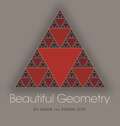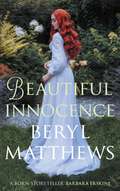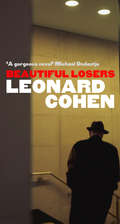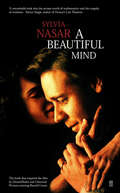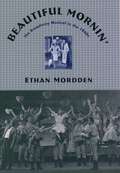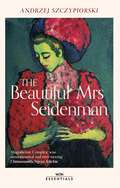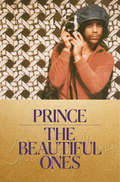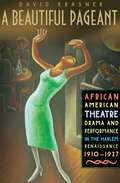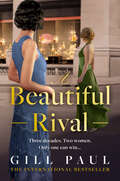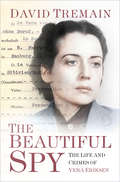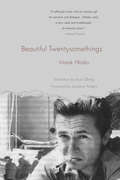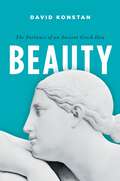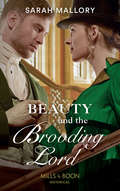- Table View
- List View
Beautiful Geometry (PDF)
by Eli Maor Eugen JostIf you've ever thought that mathematics and art don't mix, this stunning visual history of geometry will change your mind. As much a work of art as a book about mathematics, Beautiful Geometry presents more than sixty exquisite color plates illustrating a wide range of geometric patterns and theorems, accompanied by brief accounts of the fascinating history and people behind each. With artwork by Swiss artist Eugen Jost and text by math historian Eli Maor, this unique celebration of geometry covers numerous subjects, from straightedge-and-compass constructions to intriguing configurations involving infinity. The result is a delightful and informative illustrated tour through the 2,500-year-old history of one of the most important branches of mathematics.
Beautiful Imperialist: China Perceives America, 1972-1990
by David ShambaughFrom President Nixon's historic visit to China in 1972 to the aftermath of the Tiananmen tragedy, this book examines the changing perceptions of the United States articulated by China's "America Watchers," whose occupation is to interpret the "beautiful imperialist" for China's elite and public. While other studies have looked at the behavioral history of U.S.-China relations, this is the first to probe the perceptual dimension.
Beautiful Imperialist: China Perceives America, 1972-1990
by David ShambaughFrom President Nixon's historic visit to China in 1972 to the aftermath of the Tiananmen tragedy, this book examines the changing perceptions of the United States articulated by China's "America Watchers," whose occupation is to interpret the "beautiful imperialist" for China's elite and public. While other studies have looked at the behavioral history of U.S.-China relations, this is the first to probe the perceptual dimension.
Beautiful Imperialist: China Perceives America, 1972-1990
by David ShambaughFrom President Nixon's historic visit to China in 1972 to the aftermath of the Tiananmen tragedy, this book examines the changing perceptions of the United States articulated by China's "America Watchers," whose occupation is to interpret the "beautiful imperialist" for China's elite and public. While other studies have looked at the behavioral history of U.S.-China relations, this is the first to probe the perceptual dimension.
Beautiful Innocence: The heart-warming Victorian saga of triumph over adversity
by Beryl MatthewsLondon, 1900. Hester Stanmore watches in disbelief as the court declares her attacker 'not guilty', and the room erupts into chaos. The man in the dock is being congratulated as if he were a hero, but she has seen the madness in his eyes when he had attacked her. In a rage he had beaten her senseless and left her for dead. It was only her strength that allowed her to survive.Hester was determined to bring him to justice, but what would happen now? As she endeavours to pick up the pieces of her life, Hester meets Daniel Hansen, and perhaps she will find the happy ending she justly deserves .
A Beautiful Lie
by Irfan MasterAn extraordinarily rich debut novel, set in India in 1947 at the time of Partition. Although the backdrop is this key event in Indian history, the novel is even more far-reaching, touching on the importance of tolerance, love and family. The main character is Bilal, a boy determined to protect his dying father from the news of Partition - news that he knows will break his father's heart. With great spirit and determination, and with the help of his good friends, Bilal persuades others to collude with him in this deception, even printing false pages of the local newspaper to hide the ravages of unrest from his father. All that Bilal wants is for his father to die in peace. But that means Bilal has a very complicated relationship with the truth...
Beautiful Losers
by Leonard CohenOne of the best-known experimental novels of the 1960s, this uninhibited tale centres on the hapless members of a love triangle, and their sexual obsession and shared fascination with a mythic saint.
A Beautiful Mind (Shooting Script Ser.)
by Sylvia NasarA Beautiful Mind is Sylvia Nasar's award-winning biography about the mystery of the human mind, the triumph over incredible adversity, and the healing power of love.At the age of thirty-one, John Nash, mathematical genius, suffered a devastating breakdown and was diagnosed with schizophrenia. Yet after decades of leading a ghost-like existence, he was to re-emerge to win a Nobel Prize and world acclaim. A Beautiful Mind has inspired the Oscar-winning film directed by Ron Howard and featuring Russell Crowe in the lead role of John Nash.
Beautiful Mornin': The Broadway Musical in the 1940s
by Ethan Mordden"Music and girls are the soul of musical comedy," one critic wrote, early in the 1940s. But this was the age that wanted more than melody and kickline form its musical shows. The form had been running on empty for too long, as a formula for the assembly of spare parts--star comics, generic love songs, rumba dancers, Ethel Merman. If Rodgers and Hammerstein hadn't existed, Broadway would have had to invent them; and Oklahoma! and Carousel came along just in time to announce the New Formula for Writing Musicals: Don't have a formula. Instead, start with strong characters and atmosphere: Oklahoma!'s murderous romantic triangle set against a frontier society that has to learn what democracy is in order to deserve it; or Carousel's dysfunctional family seen in the context of class and gender war. With the vitality and occasionally outrageous humor that Ethan Mordden's readers take for granted, the author ranges through the decade's classics--Pal Joey, Lady in the Dark, On the Town, Annie Get Your Gun, Phinian's Rainbow, Brigadoon, Kiss Me, Kate, South Pacific. He also covers illuminating trivia--the spy thriller The Lady Comes Across, whose star got so into her role that she suffered paranoid hallucinations and had to be hospitalized; the smutty Follow the Girls, damned as "burlesque with a playbill" yet closing as the longest-run musical in Broadway history; Lute Song, in which Mary Martin and Nancy Reagan were Chinese; and the first "concept" musicals, Allegro and Love Life. Amid the fun, something revolutionary occurs. The 1920s created the musical and the 1930s gave it politics. In the 1940s, it found its soul.
The Beautiful Mrs Seidenman: With an introduction by Chimamanda Ngozi Adichie (W&N Essentials)
by Andrzej Szczypiorski'Magnificent. Complex, wise, unsentimental and very moving' Chimamanda Ngozi Adichie'Dense, lyrical and deeply unsettling' New York Times'A fine balance between poetic tenderness and an unflinching account of the brutal realities of the day' Guardian'Extraordinarily original' Los Angeles Times'The prose is stunning, thanks to a masterful translation by Klara Glowczewska, and the characters are so fully fleshed that they seem to step off the page' NPR'Grips the reader with the power of a high-class thriller' Frankfurter Rundschau 'All at once she thought that a life is only that which has passed. There is no life other than memory' In the Nazi-occupied Warsaw of 1943, Irma Seidenman, a young Jewish widow, possesses two attributes that can spell the difference between life and death: blue eyes and blond hair. Paired with false papers, she passes as the wife of a Polish officer, until one day an informer spots her on the street.At times a dark lament, at others a sly and sardonic thriller, The Beautiful Mrs. Seidenman is the story of the thirty-six hours that follow Irma's arrest and the events that lead to her dramatic rescue.
Beautiful Mutants: Beautiful Mutants, Swallowing Geography, The Unloved
by Deborah LevyBeautiful Mutants is a stunning early novel by the Man Booker-shortlisted Deborah Levy. Levy's surreal and artful first novel, Beautiful Mutants, introduces Lapinski -- the manipulative and magical Russian exile who summons forth a number of urban pilgrims in a shimmering contemporary allegory about broken dreams and desires . . .'A stunningly original writer' Kirsty Gunn'It throbs its way into the imagination like the unguided missiles it decries' Observer'Levy's strength is her originality of thought and expression' Jeanette WintersonDeborah Levy writes fiction, plays and poetry. Her work has been staged by the Royal Shakespeare Company, and she is the author of highly praised books including The Unloved, Things I Don't Want to Know, Swallowing Geography and Billy and Girl. Her novel Swimming Home was shortlisted for the 2012 Man Booker Prize, 2012 Specsavers National Book Awards (UK Author of the Year) and 2013 Jewish Quarterly Wingate Prize, while the title story of her most recent work of fiction, Black Vodka, was shortlisted for the 2012 BBC International Short Story Award.
The Beautiful Ones
by Prince'A triumph... The Beautiful Ones rivals the Beastie Boys Book – or even your favourite Prince song – as a masterclass in the bottling of its subject’s seductive essence... his presence in this book is so strong that it’s hard to believe he has really left the building’ *****MOJO______________________________________________From Prince himself comes the brilliant coming-of-age-and-into-superstardom story of one of the greatest artists of all time—featuring never-before-seen photos, original scrapbooks and lyric sheets, and the exquisite memoir he began writing before his tragic death. Prince was a musical genius, one of the most talented, beloved, accomplished, popular, and acclaimed musicians in pop history. But he wasn't only a musician—he was also a startlingly original visionary with an imagination deep enough to whip up whole worlds, from the sexy, gritty funk paradise of his early records to the mythical landscape of Purple Rain to the psychedelia of Paisley Park. But his greatest creative act was turning Prince Rogers Nelson, born in Minnesota, into Prince, the greatest pop star of his era. The Beautiful Ones is the story of how Prince became Prince—a first-person account of a kid absorbing the world around him and then creating a persona, an artistic vision, and a life, before the hits and fame that would come to define him. The book is told in four parts. The first is composed of the memoir he was writing before his tragic death, pages that brings us into Prince's childhood world through his own lyrical prose. The second part takes us into Prince's early years as a musician, before his first album released, through a scrapbook of Prince's writing and photos. The third section shows us Prince's evolution through candid images that take us up to the cusp of his greatest achievement, which we see in the book's fourth section: his original handwritten treatment for Purple Rain—the final stage in Prince's self-creation, as he retells the autobiography we've seen in the first three parts as a heroic journey. The book is framed by editor Dan Piepenbring’s riveting and moving introduction about his short but profound collaboration with Prince in his final days—a time when Prince was thinking deeply about how to reveal more of himself and his ideas to the world, while retaining the mystery and mystique he’d so carefully cultivated—and annotations that provide context to each of the book’s images. This work is not just a tribute to Prince, but an original and energizing literary work, full of Prince’s ideas and vision, his voice and image, his undying gift to the world.
A Beautiful Pageant: African American Theatre, Drama and Performance in the Harlem Renaissance
by D. KrasnerThe Harlem Renaissance was an unprecedented period of vitality in the American Arts. Defined as the years between 1910 and 1927, it was the time when Harlem came alive with theater, drama, sports, dance and politics. Looking at events as diverse as the prizefight between Jack Johnson and Jim 'White Hope' Jeffries, the choreography of Aida Walker and Ethel Waters, the writing of Zora Neale Hurston and the musicals of the period, Krasner paints a vibrant portrait of those years. This was the time when the residents of northern Manhattan were leading their downtown counterparts at the vanguard of artistic ferment while at the same time playing a pivotal role in the evolution of Black nationalism. This is a thrilling piece of work by an author who has been working towards this major opus for years now. It will become a classic that will stay on the American history and theater shelves for years to come.
The Beautiful Railway Bridge of the Silvery Tay: Reinvestigating the Tay Bridge Disaster of 1879
by Peter LewisOver 125 years ago, barely a year and a half after the Tay Railway Bridge was built, William McGonnagal composed his poem about the Tay Bridge Disaster, the poem about Britain's worst-ever civil engineering disaster. Over 80 people lost their lives in the fall of the Tay Bridge, but how did it happen? The accident reports say that high wind and poor construction were to blame, but Peter Lewis, an Open University engineering professor, tells the real story of how the bridge so spectacularly collapsed in December 1879.
A Beautiful Rival
by Gill PaulThe world is at war, but on the gilded streets of Fifth Avenue, New York, a battle of a different kind is brewing…
The Beautiful Spy: The Life and Crimes of Vera Eriksen
by David TremainIn September 1940 a beautiful young woman arrived by seaplane and rubber dinghy on the shores of Scotland accompanied by two men – one of Germany’s many attempt to penetrate British defences and infiltrate spies into the UK. This seems to be one of the few established facts in the otherwise mysterious tale of Vera Eriksen. Even the origins of the woman described as ‘the most beautiful spy’ remain hazy, as does her ultimate fate. David Tremain delves into the archives, and in doing so begins to reveal glimpses of her fascinating life story: her career as a dancer in Paris; a tumultuous and violent dalliance with a White Russian officer of uncertain identity; her time in England with the Duchesse de Château-Thierry, an Abwehr agent; the suspicious and untimely death of her husband, and a rumoured pregnancy. The Beautiful Spy also grapples with perhaps the biggest mystery of all: what happened to Vera after she was released by the British?
Beautiful Tempest: A Novel (Malory-anderson Family Ser. #12)
by Johanna LindseyIn her new Malory-Anderson Family novel, Beautiful Tempest, No. 1 New York Times bestselling author Johanna Lindsey reveals the tempestuous story of Jacqueline Malory whose furious desire for revenge leads to a confrontation with the handsome pirate who abducted her - and sparks a much steamier kind of desire.For the first time, James Malory and his Anderson in-laws agree on something: it's payback time for the culprit who kidnapped James and Georgina's beloved daughter Jack from her American debutante party and whisked her away to the Caribbean, no matter that she escaped unscathed. James figured out who masterminded the dastardly plot and is leading a fleet of ships to the West Indies to deliver some Malory-style retribution.More interested in revenge than in finding a husband during her first London Season, Jack is furious that her father left her behind. Then an intriguing stranger leads her and her older brother Jeremy to her mysterious abductor. But instead of capturing him, the Malory siblings wind up as his 'guests' on a ship sailing away from England. As Jack re-engages in a battle of wills with her all too attentive captor, she realizes he is no ordinary pirate, perhaps no pirate at all, but a nobleman determined to settle a score that dates back to the days when her father was known as Captain Hawk - and what endangers her most is the increasingly passionate attraction they feel for each other.Utterly captivating. Wonderfully entertaining. Let legendary author Johanna Lindsey capture your heart with her unforgettable romance.
The Beautiful Truth
by Belinda SeawardSet in Poland in the present and during the Second World War, The Beautiful Truth is an unforgettable novel of families, heroism and of the possibilities of finding late love. For readers of Helen Dunmore, Sadie Jones and Rose Tremain.'A thrillingly observant writer and crafter of highly sensual prose' Daily MailCatherine never knew her father. A Polish exile, he disappeared when she was a small child, leaving her only a pair of binoculars and a lifelong love of the stars. Now in her forties, she leads a settled academic life in Cambridge - until one day she receives a letter with a Polish postmark from an American film-maker who is in Krakow to research the wartime experiences of his aunt. What Konrad has uncovered will send Catherine on a voyage of discovery not only into Poland's past, but into her own history. And what she uncovers there will change her life in ways she could not possibly have imagined.Moving between present-day Krakow and wartime Poland, The Beautiful Truth tells a passionate and moving story of the way ordinary lives are swept up in extraordinary events. Heartbreaking and uplifting in equal measure, it will not be easily forgotten.
Beautiful Twentysomethings (NIU Series in Slavic, East European, and Eurasian Studies)
by Marek HlaskoMarek Hlasko's literary autobiography is a vivid, first-hand account of the life of a young writer in 1950s Poland and a fascinating portrait of the ultimately short-lived rebel generation. Told in a voice suffused with grit and morbid humor, Hlasko's memoir was a classic of its time. In it he recounts his adventures and misadventures, moving swiftly from one tale to the next. Like many writers of his time, Hlasko also worked in screen writing, and his memoir provides a glimpse into just how markedly the medium of film affected him from his very earliest writing days.The memoir details his relationships with such giants of Polish culture as the filmmaker Roman Polanski and the novelist Jerzy Andrzejewski. Hlasko is the most prominent example of a writer who broke free from the Socialist-Realist formulae that dominated the literary scene in Poland since it fell under the influence of the Soviets. He made his literary debut in 1956 and immediately became a poster boy for Polish Literature. He subsequently worked at some of the most important newspapers and magazines for intellectual life in Warsaw. Hlasko was sent to Paris on an official mission in 1958, but when he published in an \u00e9migr\u00e9 Parisian press his novel of life in post-War Poland, he was denied a renewal of his passport. In effect, he was called back to Poland, and when he refused to return he was stripped of his Polish citizenship. He spent the rest of his life working in exile.Marek Hlasko was a rebel whose writing and iconoclastic way of life became an inspiration to those of his generation and after. Here, in the first English translation of his literary memoir, Ross Ufberg deftly renders Hlasko's wry and passionate voice.
Beauty: The Fortunes of an Ancient Greek Idea (Onassis Series in Hellenic Culture)
by David KonstanWhat does it mean to say something is beautiful? On the one hand, beauty is associated with erotic attraction; on the other, it is the primary category in aesthetics, and it is widely supposed that the proper response to a work of art is one of objective contemplation. At its core, then, beauty is a contested concept, and both sides feel comfortable appealing to the authority of Plato, and via him, to the ancient Greeks generally. So, who is right-if either? Beauty offers an elegant investigation of ancient Greek notions of beauty and, in the process, sheds light on how we ought to appreciate the artistic achievements of the classical world. The book opens by reexamining the commonly held notion that the ancient Greeks possessed no term that can be unambiguously defined as "beauty" or "beautiful." Author David Konstan discusses a number of Greek approximations before positioning the heretofore unexamined term kállos as the key to bridging the gap between beauty and desire, and tracing its evolution as applied to physical beauty, art, literature, and more. The book then examines corresponding terms in Biblical Hebrew and ancient Latin literature to highlight the survival of Greek ideas in the Latin West. The final chapter compares the ancient Greek conception of beauty with modern notions of beauty and aesthetics. In particular, it focuses on the reception of classical Greek art in the Renaissance and how Vasari and his contemporaries borrowed from Plato the sense that the beauty in art was transcendental, but left out the erotic dimension of viewing. Even if Greece was the inspiration for modern aesthetic ideals, this study illustrates how the Greek view of the relationship between beauty and desire was surprisingly consistent-and different from our own. This fascinating and magisterial exploration makes it possible to identify how the Greeks thought of beauty, what it was that attracted them, and what their perceptions can still tell us about art, love, desire-and beauty.
Beauty: The Fortunes of an Ancient Greek Idea (Onassis Series in Hellenic Culture)
by David KonstanWhat does it mean to say something is beautiful? On the one hand, beauty is associated with erotic attraction; on the other, it is the primary category in aesthetics, and it is widely supposed that the proper response to a work of art is one of objective contemplation. At its core, then, beauty is a contested concept, and both sides feel comfortable appealing to the authority of Plato, and via him, to the ancient Greeks generally. So, who is right-if either? Beauty offers an elegant investigation of ancient Greek notions of beauty and, in the process, sheds light on how we ought to appreciate the artistic achievements of the classical world. The book opens by reexamining the commonly held notion that the ancient Greeks possessed no term that can be unambiguously defined as "beauty" or "beautiful." Author David Konstan discusses a number of Greek approximations before positioning the heretofore unexamined term kállos as the key to bridging the gap between beauty and desire, and tracing its evolution as applied to physical beauty, art, literature, and more. The book then examines corresponding terms in Biblical Hebrew and ancient Latin literature to highlight the survival of Greek ideas in the Latin West. The final chapter compares the ancient Greek conception of beauty with modern notions of beauty and aesthetics. In particular, it focuses on the reception of classical Greek art in the Renaissance and how Vasari and his contemporaries borrowed from Plato the sense that the beauty in art was transcendental, but left out the erotic dimension of viewing. Even if Greece was the inspiration for modern aesthetic ideals, this study illustrates how the Greek view of the relationship between beauty and desire was surprisingly consistent-and different from our own. This fascinating and magisterial exploration makes it possible to identify how the Greeks thought of beauty, what it was that attracted them, and what their perceptions can still tell us about art, love, desire-and beauty.
Beauty and Atrocity: People, Politics And Irelandâs Fight For Peace
by Joshua LevineAn ambitious and powerful account of modern Irish history through the eyes of those who experienced it at first hand.
Beauty And The Brooding Lord: Convenient Christmas Brides An Earl For The Wallflower Widow Beauty And The Brooding Lord (Saved From Disgrace #2)
by Sarah MalloryRuined by a rake… Rescued by the reclusive Baron!
Beauty and Business: Commerce, Gender, and Culture in Modern America (Hagley Perspectives on Business and Culture)
by Philip ScrantonLeading historians explore how our ideas of what is attractive are influenced by a broad range of social and economic factors. They force us to reckon with the ways that beauty has been made, bought and sold in modern America.
Beauty and Business: Commerce, Gender, and Culture in Modern America (Hagley Perspectives on Business and Culture)
by Philip ScrantonLeading historians explore how our ideas of what is attractive are influenced by a broad range of social and economic factors. They force us to reckon with the ways that beauty has been made, bought and sold in modern America.
